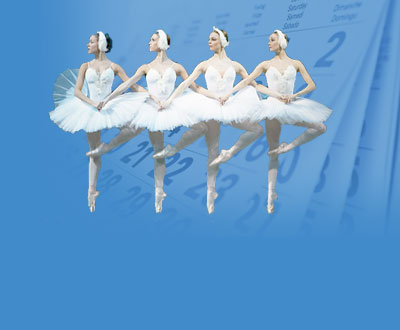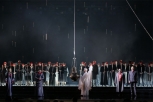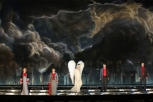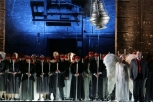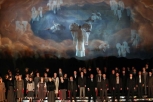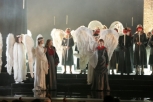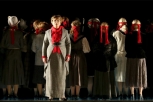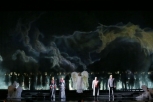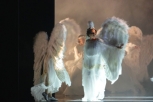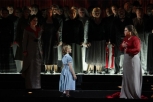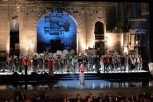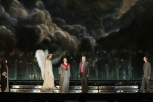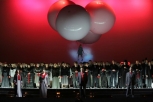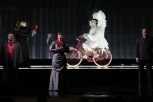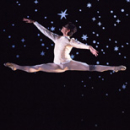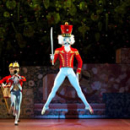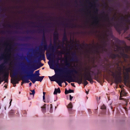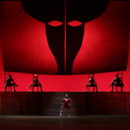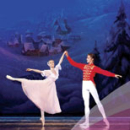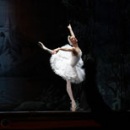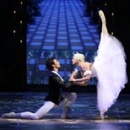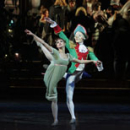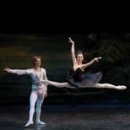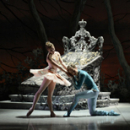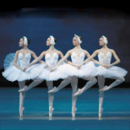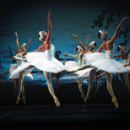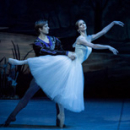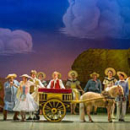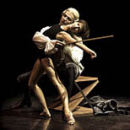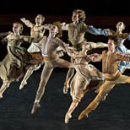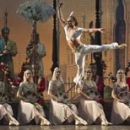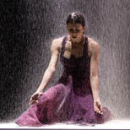Schedule of all St. Petersburg theaters on
one page >>
Please enter theatre's name, actor's name or any other keyword
Verdi. Requiem (Mariinsky Theatre, opera)
Genre: Ballet Age restriction: 12+ Length: 1 hours 30 minutes
Credits
Musical Director: Valery Gergiev
Director: Daniele Finzi Pasca
Production Concept: Daniele Finzi Pasca and Julie Hamelin
Set Designer: Jean Rabasse
Costume Designer: Giovanna Buzzi
Lighting Designer: Daniele Finzi Pasca and Alexis Bowles
Video Designer: Roberto Vitalini
Make-Up Designer: Chiqui Barbé
Assistant Director: Alona Umanskaya
Assistant Set Designer: Myriam Rose
Assistant Costume Designer: Lisa Rufini
Artists
Tatiana Pavlovskaya (soprano)
Yulia Matochkina (mezzo-soprano)
Migran Agadzhanyan (tenor)
Stanislav Trofimov (bass)
Chorus and Symphony Orchestra of the Mariinsky Theatre
Principal Chorus Master and Conductor: Andrei Petrenko
“There are already so very many, many funereal masses! There is no need to add another to them,” the sixty-five-yearold Giuseppe Verdi said modestly, putting aside the sketches for his Requiem... in order to return to his idea rather soon in 1874 to complete his own funereal mass. What made the opera composer take a text from a Catholic service and drop the sensuality of Italian for the severity of Latin? The shadows of his great fellow Italians Gioachino Rossini and Alessandro Manzoni cast themselves over this story, the flames of which were fanned by Verdi’s fervent patriotism.
Rossini died in 1868 at his villa in a suburb of Paris. Verdi had never held any particularly warm feelings for him, but the composer’s death disturbed him deeply – “He was the pride of Italy.” Soon after, he proposed that the greatest Italian composers combine forces to write a requiem in Rossini’s memory. But the nobly-intended initiative was silenced by circumstances. On 22 May 1873 the country experienced yet another loss – the death of the poet Alessandro Manzoni, the father of Italian romanticism. Verdi had adored Manzoni and was ready to make whatever effort necessary in order to honour the memory of this idol of the age. This time everything worked out the way the composer planned. The triumphant premiere took place in Milan under the baton of the composer and featured Italy’s finest singers. Then came Paris, London, Berlin, Vienna and St Petersburg...
In the 21st century the emotional power of the music, unable to resist cult status, has drawn the attention of stage directors. The Requiem has been staged at the Berliner Staatsoper by Achim Freyer, in Tampere in Finland by Jiři Nekvasil and at the Musorgsky Opera and Ballet Theatre in St Petersburg by Stanislav Gaudasinsky, while Japanese director Ikuto Yamamoto staged a production featuring performers of Japan’s Imperial Kabuki Theatre. The desire to turn the mass into a production can be explained by Verdi’s very musical style itself. Verdi went down in history as an insightful opera reformer. He readily embraced the most contemporary themes, seeking out plots that were “new, meaningful, beautiful, varied... and incredibly bold...” The composer was ready to accept the most radical stage methods on offer at the time: “... there’s a situation which is thrusting itself forwards, but save us from it, oh God! We would be killed. It would be better to show Gilda with the Duke in his bedroom!!! You understand? At least that would be a duet. A magnificent duet!!! But priests, monks and canting hypocrites would yell about the scandal.” And yell they did, only in connection with the opera maestro’s “hijacking” the genre of church music. The premiere of the Requiem at the Church of San Marco was almost the only performance of the work in a church during the composer’s lifetime. Three days later the Requiem was performed at La Scala, later being performed in concerts halls and, more regularly, theatres.
Of course, in the latter half of the 19th century it was already no longer possible to demand that composers followed church canons literally – works to liturgical texts had long since left churches for the stage. But even against such a background as this Verdi’s Requiem stands apart for its open humanity and vivid theatricality. Why? Perhaps it was the generalised Latin text that gave it the desired freedom from operatic cliches against which he had battled his entire life? This freedom allowed Verdi to concentrate on the most important thing – human emotions at that fateful instant between life and death, expressing them in perfect musical form where fiery passion is equalled by moments of heavenly purity and noble severity. Individual sections of the Requiem bring to mind operatic scenes with perturbed recitatives and expressive ariosos. Now the chorus rings out furiously, now it moves to barely audible declamation, almost a whisper. Verdi was as if aiming to compensate the lack of a stage plot with deliberately stressed and specific aural imagery. The anxious “fluttering” of the strings in the Lux aeterna (The Eternal Light), the squally whirlwinds and staggering spatial effect of the proximity of the trumpets heralding the Day of Judgement in the Dies irae (The Day of Wrath)... It is in the grandiose second section that the Requiem’s tragic idea is most vividly embodied. With Verdi, the Dies irae is split into nine episodes including the Day of Judgement intermixed with deeply penetrating vocal declarations that convey the emotions of weak mankind in the face of Death. The musical images of the first sections return in the Requiem’s grandiose finale, Libera me (Deliver Me), in which mankind once again meets with a power that is alien to him. Going against tradition, the result is that the Requiem is not at all a prayer for eternal peace. In the frenetic solos of the finale, where horror of the unavoidable and deep repentance are expressed with all possible directness, one can sense not peace but rather the eternal striving for happiness that moves the characters in Verdi’s operas. “Can peace and love get along in one heart?” de Beaumarchais asked. The answer is clear, because in Verdi’s music the force of love is always greater than the force of destiny.
Anastasia Mursalova
You may also like
-
The Nutcracker (Mikhailovsky Theatre, ballet)
Mikhailovsky (ex. Mussorgsky) Theatre- Genre: Ballet
-
The Nutcracker (Hermitage Theatre, ballet)
Hermitage Theatre- Genre: Ballet
-
The Nutcracker (Mariinsky Theatre, ballet)
Mariinsky (ex. Kirov) Ballet and Opera Theatre- Genre: Ballet
-
Die Fledermaus (Mariinsky II (New) Theatre, ballet)
Mariinsky II (New) Theatre- Genre: Ballet
-
Carmen Suite. Sacre (Mariinsky II New Theatre, ballet)
Mariinsky II (New) Theatre- Genre: Ballet
-
Let It Snow! Let It Snow! Let It Snow! (Mikhailovsky Theatre, ballet)
Mikhailovsky (ex. Mussorgsky) Theatre- Genre: Ballet
-
The Nutcracker (Alexandrinsky Theatre, ballet)
Alexandrinsky Theatre- Genre: Ballet
-
Swan Lake (Aurora Ballet Hall, ballet)
Aurora Ballet Hall- Genre: Ballet
-
Cinderella (Mikhailovsky Theatre, ballet)
Mikhailovsky (ex. Mussorgsky) Theatre- Genre: Ballet
-
Die Zauberflote (Mariinsky II (New) Theatre, ballet)
Mariinsky II (New) Theatre- Genre: Ballet
-
The Nutcracker (Mariinsky II New Theatre, ballet)
Mariinsky II (New) Theatre- Genre: Ballet
-
Swan Lake (Carnival Concert Hall, ballet)
Carnival Concert Hall- Genre: Ballet
-
The Little Humpbacked Horse (Mikhailovsky Theatre, ballet)
Mikhailovsky (ex. Mussorgsky) Theatre- Genre: Ballet
-
Don Pasquale (Mariinsky Theatre, ballet)
Mariinsky (ex. Kirov) Ballet and Opera Theatre- Genre: Ballet
-
Les contes d'Hoffmann (semi-staged performance) (Mariinsky II (New) Theatre, ballet)
Mariinsky II (New) Theatre- Genre: Ballet
-
The Sleeping Beauty (Mikhailovsky Theatre, ballet)
Mikhailovsky (ex. Mussorgsky) Theatre- Genre: Ballet
-
Swan Lake (Mariinsky Theatre, ballet)
Mariinsky (ex. Kirov) Ballet and Opera Theatre- Genre: Ballet
-
Spartacus (Mikhailovsky Theatre, ballet)
Mikhailovsky (ex. Mussorgsky) Theatre- Genre: Ballet
-
Don Quixote (Mikhailovsky Theatre, ballet)
Mikhailovsky (ex. Mussorgsky) Theatre- Genre: Ballet
-
Swan Lake (Mikhailovsky Theatre, ballet)
Mikhailovsky (ex. Mussorgsky) Theatre- Genre: Ballet
-
Le Corsaire (Mikhailovsky Theatre, ballet)
Mikhailovsky (ex. Mussorgsky) Theatre- Genre: Ballet
-
Giselle, ou Les Wilis (Mikhailovsky Theatre, ballet)
Mikhailovsky (ex. Mussorgsky) Theatre- Genre: Ballet
-
Notre-Dame de Paris (Mikhailovsky Theatre, ballet)
Mikhailovsky (ex. Mussorgsky) Theatre- Genre: Ballet
-
La Fille mal gardée (Mikhailovsky Theatre, ballet)
Mikhailovsky (ex. Mussorgsky) Theatre- Genre: Ballet
-
Multiplicity. Forms of Silence and Emptiness (Mikhailovsky Theatre, ballet)
Mikhailovsky (ex. Mussorgsky) Theatre- Genre: Ballet
-
Laurencia (Mikhailovsky Theatre, ballet)
Mikhailovsky (ex. Mussorgsky) Theatre- Genre: Ballet
-
The Flames of Paris (Mikhailovsky Theatre, ballet)
Mikhailovsky (ex. Mussorgsky) Theatre- Genre: Ballet
-
Romeo and Juliet (Mikhailovsky Theatre, ballet)
Mikhailovsky (ex. Mussorgsky) Theatre- Genre: Ballet
-
La Bayadère (Mikhailovsky Theatre, ballet)
Mikhailovsky (ex. Mussorgsky) Theatre- Genre: Ballet
-
Without Words. Duende. White Darkness (Mikhailovsky Theatre, ballet)
Mikhailovsky (ex. Mussorgsky) Theatre- Genre: Ballet


 en
en es
es